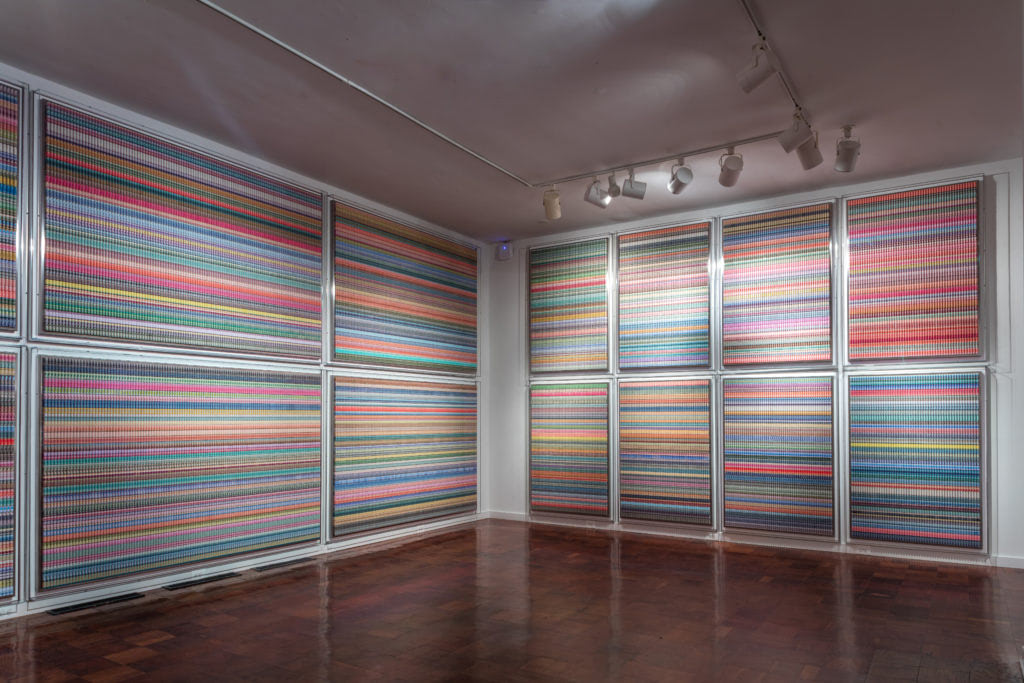When art is (literally) money, Tru Vue® preserves value(s)
When a major Washington, DC exhibition of a Colombian artist needed professional grade display cases, they turned to Miami startup Sectis Design. For the Venezuelan owners of Sectis, the opportunity to mount Santiago Montoya’s work at the Organization of American States (OAS) was an honor with multi-layered resonances. They decided Tru Vue® Optium Museum Acrylic® would be the only acrylic display to fit the bill.
Rising Colombian artist Santiago Montoya garnered an international reputation for his exploration of our interaction with money. He uses real currency notes from various countries whose power dynamics interest him – either because of their domestic governance or their roles on the world stage – to create pointillist portraits of power. The pointillist works can form words, such as ‘blah’ in his work ‘Money Talks’, or they can have world leaders face off in an expression of codependency, as in the work where George Washington on the US $1 bill faces east to gaze upon a Westward facing Chairman Mao from the Yuan bill.
Montoya’s work recognizes that currencies are the locus of nationalist and propagandist iconography: bills are the very means of measuring the value of every exchange they make, and the images on them tell the citizens what they should value, and his vast works full of paper money, express the diminution of the individual relative to the complex financial system to which we as citizens are subjected, yet understand poorly. The titles of the works, English-language clichés expressing the potentially nefarious power of money over the average citizen (‘The Great Swindle,’ ‘Money Talks’), only amplify the David-versus-Goliath tension between consumers and money.

For the mounting of the OAS exhibition of ‘The Great Swindle,’ (October 20, 2016 – March 26, 2017), Montoya’s London gallery Halcyon chose their trusted partners at Sectis Design; Sectis knew only one acrylic product would meet the exacting demands: Tru Vue®. Since they needed to virtually eliminate reflections, as well UV protection with optimal light transmission, they chose Optium Museum Acrylic® to protect the integrity of the color and texture of thousands of currency notes that must remain even and smooth, protected from both fading from light or bubbling by variations in humidity. The effectiveness of Sectis’s work with Tru Vue® Optium® is evident in the display, a clean edge and no bubble in sight, of ‘One Man, Many People,’ now in the permanent collection of the OAS, a magisterial building right on Constitution Avenue, befitting its role as hemispheric arbiter of democracy and human rights. The OAS motto is: “more rights for more people.”
There is certain poetic elegance to art’s ability not only to imitate life, but crystalize its complexities. Montoya’s OAS exhibition ‘The Great Swindle’ has deep resonance for Latin Americans, who have always had a complicated relationship with sovereign debt and American capitalism. The OAS is now a strong advocate of a restoration of social justice in Venezuela, the home country of Sectis Design owner and founder, Ricardo Neumann, who has art, design and social awareness in his blood. Hailing from a family of entrepreneurs and art collectors, who funded museums and art schools, he has rebuilt his family’s life in Miami’s design district after fleeing a country where government corruption and mismanagement triggered the collapse of the economy and currency.
Share this Article:
This article is intended for educational purposes only and does not replace independent professional judgment. Statements of fact and opinions expressed are those of the author(s) individually and, unless expressly stated to the contrary, are not the opinion or position of Tru Vue or its employees. Tru Vue does not endorse or approve, and assumes no responsibility for, the content, accuracy or completeness of the information presented.
